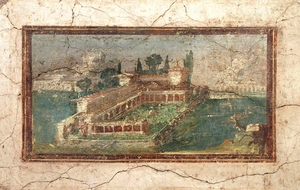San Antonio
If, as the medieval saying goes, all roads lead to Rome, might the artistic path to landscape painting trace back to the eternal city as well? That is a theme of "Roman Landscapes: Visions of Nature and Myth From Rome and Pompeii" at the San Antonio Museum of Art, which has gathered about 65 wall paintings, relief sculptures, mosaics, and glass and metal vessels created between 100 B.C. and about A.D. 250 as evidence.
 Garden fresco, Pompeii |
 Wellhead |
"Roman Landscapes," which the museum calls the first exhibition in the U.S. to showcase these ancient works, exposes the trappings of life around Pompeii, the Bay of Naples and Rome itself, where the wealthy decorated their villas with depictions of gardens, picturesque and mythological scenes, exotic Egypt (then controlled by Rome) and shrines. Many pieces have never been shown here before, including a marble wellhead from the mid- to late first century B.C. of dancing satyrs and maenads in a rustic setting.
 Wall Painting With a Seaside Villa |
From there, the exhibition unfolds thematically. One section explores gardens. The lovely three-panel "Wall Painting With Sculptures and Birds in a Garden" (late first century B.C.-early first century A.D.), from the House of the Golden Bracelet in Pompeii, featuring doves, orioles, a bird bath, garden sculptures, trees and a view of the bay, would have brought the outside inside to Romans at dinner. "Wall Painting With a Miniature Garden" (late first century B.C.-mid-first century A.D.) from Herculaneum, which shows four white herons (or egrets) walking near a beautifully caned fence and manicured garden, and "Wall Painting With a Garden and Birds" (late first century B.C.-mid-first century A.D.), which places one bird on a cross-hatched wooden fence enclosing a dense garden, from Pompeii, achieve a similar feat and embody the loose, impressionistic style of all the paintings here.
 Old Fisherman |
Equally absorbing artworks populate sections devoted to coastal views, sacred landscapes, mythical landscapes, and funerary art, and several stand out. "Wall Painting With a Procession to the Tomb" (late first century B.C.), from the Tomb of Patron in Rome, presents a march by the delicately rendered members of the deceased's family through a grove of trees. "Wall Painting With a Seaside Villa" (mid-first century A.D.) depicts a fortress-like home with an extensive garden, built out into the water. One can imagine walking through its colonnaded porticos, charmed by the scent and the view.
 Plato's Academy |
These two works shine in part because, as visitors will no doubt notice, ancient Roman landscapes clung to a limited number of motifs, lacking much inventiveness. Even so, the fresh topic of this exhibition makes it a welcome, provocative look at new territory.

